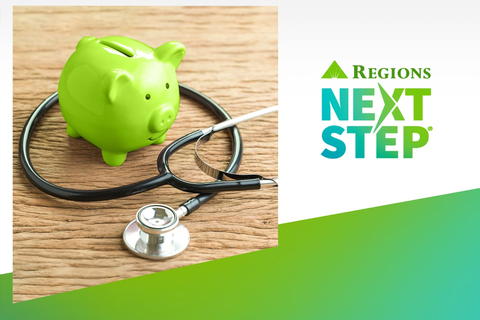Regions Next Step Survey Finds Many Americans Aren’t Prepared for Medical Expenses
Regions Next Step financial wellness program offers no-cost tools to help people navigating medical financial hardship

The survey was conducted by Regions Next Step, the bank’s no-cost financial education program that serves people of all ages, regardless of whether they bank with Regions. According to the survey, six in 10 (
Despite this, the survey finds many people are not able to cover medical bills when they are due. Two in five people have experienced an unexpected medical event in the last year and, among those, seven in 10 found it difficult to pay for it. Younger respondents were among the most likely to have trouble paying.
Additionally, more than one in three people (
Further, medical expenses and debt are taking a toll on peoples’ savings. Due to the cost of medical bills in the last year, nearly one-quarter of Americans has either used all their savings to cover the expenses or has been contacted by a collection agency due to medical bills.
Results also show there are knowledge gaps when it comes to options for tackling medical debt. Approximately half of respondents (
“Medical events can be traumatic and unpredictable – and the resulting debt can add greater stress to the healing process. Being prepared beforehand and knowing how to address medical debt can make a significant difference to staying on track with your finances,” said
Additional key findings of the survey include:
- One in three Americans has delayed going to the doctor or scheduling a procedure because of money concerns related to an unexpected medical event. Another one in five has skipped a recommended medical test or treatment altogether.
-
For those with medical debt,
75% said daily expenses, such as food, clothing and transportation, were the greatest barriers to repayment. Other barriers included:-
Housing payments (
53% ) -
The financial impact of the pandemic (
42% )
-
Housing payments (
-
When asked how they would cover an emergency medical expense around
$1,000 20% said emergency savings. Another21% said credit card, and another19% said cash.
“During the pandemic, many Americans found themselves without work or insurance coverage, putting a strain on their ability to pay off old medical debt or manage new expenses. Even as the pandemic eases, many still struggle with this debt,” said
Regions Next Step also recommends the following tips:
- Negotiate expenses with medical providers. When expenses are not covered by insurance, negotiate with the health care provider for a lower fee or longer payment timeframe. Providers may settle the debt for less than the amount owed if a lump-sum payment if made. Alternatively, providers may set up an interest-free payment plan. Learn more tips about medical payments in this article.
- Look for ways to keep medical costs down. Thoroughly review medical bills for errors or overcharges before paying because finding and disputing errors can potentially save money. Additionally, prices can vary across providers and insurers, so shop around for the best rates and options. Some employers offer a Flexible Savings Account (FSA) or Health Savings Account (HSA), so consider enrolling in this benefit. Both types of accounts allow people with health insurance to set aside money to help cover “qualified medical expenses,” which may include deductibles, copays and prescription costs. Learn more about these strategies and other tips for managing out-of-pocket healthcare costs by taking this Next Step Course.
- Build or maintain an emergency savings fund. Build an emergency savings fund with a goal of six months of living expenses to help offset a medical emergency expense. Calculate how much you need to save to reach it and start setting aside that money each month or paycheck. Once funds are used, be sure to replenish it. Check out this article for more tips on building your emergency savings.
- Create a debt payment plan. Getting debt under control takes planning and discipline. Start by determining how much is owed and create an accurate, realistic budget. Decide how much income can be put toward debt each month and commit to making those payments. Try to pay more than the minimum payment each month, and pay on time to avoid late fees. Use this Regions calculator to create a debt payoff plan.
- Explore debt relief options. Research debt relief services and decide what may be the best fit. Explore requirements to qualify, associated fees and tax implications. Consider debt management programs, debt settlement, transferring debt or debt consolidation loans. Take this Next Step Course to learn about these options and more.
For more, visit www.Regions.com/NextStepMedicalHardship, or visit any Regions branch to speak with an associate.
The Regions Next Step omnibus survey questions were part of a national online survey that took place between
About
About Regions Next Step®
Regions Next Step is the financial education program from
View source version on businesswire.com: https://www.businesswire.com/news/home/20221129005180/en/
(205) 264-4551
Regions News Online: regions.doingmoretoday.com
Source:







